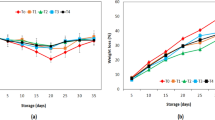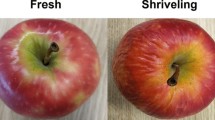Abstract
Orlando tangelo fruits, originating from tropical and subtropical regions, have demonstrated a tendency to be susceptible to chilling injury when subjected to cold storage conditions. This study investigated the effects of methyl jasmonate (MeJA) (50 µM), γ-aminobutyric acid (GABA) (5 mM), and MeJA (50 µM) + GABA (5 mM) on chilling injury of Orlando tangelo fruits throughout cold storage (90 days at 3 ± 0.5 °C plus 5 days at 20 °C, shelf life). The findings demonstrated that all treatments considerably decreased fruit weight loss. Although all treatments significantly decreased chilling injury, MeJA treatment resulted in the least amount of chilling injury. Malonaldehyde was also significantly lower in the treated fruits in comparison to the control. Maximum phenol and flavonoid were observed in the MeJA treatment, which was 1.47 and 1.63 times higher than the control fruit, respectively. On average, the antioxidant activity of the treatments was 1.33 times higher than that of the control. The treatments increased the activity of catalase (CAT) and peroxidase (POD) enzymes in fruit juice and peel. Whereas, the highest activity of CAT and POD enzymes in the peel was observed in the treatments of MeJA and MeJA + GABA, respectively. Compared to other treatments, MeJA significantly increased the activity of the CAT enzyme in the fruit peel. Even though MeJA exhibited a more pronounced positive effect, the overall results indicate that both individual treatments and MeJA + GABA could be utilized to enhance the cold tolerance of Orlando tangelo fruit during extended periods of cold storage.
Graphical abstract







Similar content being viewed by others
Data Availability
The authors confirm that the data supporting the findings of this study are available within the article.
References
L.S. Magwaza, U.L. Opara, P.J. Cronjé, S. Landahl, L.A. Terry, B.M. Nicola ï, Nonchilling physiological rind disorders in citrus fruit. Hortic. Rev. 41, 131–176 (2013)
A.A. Kader, E.M. Yahia, in Postharvest biology and technology of tropical and subtropical fruits (Woodhead Publishing, 2011), pp. 79–111
M.T. Lafuente, L. Zacarias, M.A. Martı́nez-Téllez, M.T. Sanchez-Ballesta, A. Granell, Phenylalanine ammonia-lyase and ethylene in relation to chilling injury as affected by fruit age in citrus. Postharvest Biol. Technol. 29(3), 309–318 (2003)
C. Wasternack, M. Strnad, Jasmonate signaling in plant stress responses and development–active and inactive compounds. New Biotechnol. 33(5), 604–613 (2016)
C. Wasternack, Jasmonates: an update on biosynthesis, signal transduction and action in plant stress response, growth and development. Ann. Bot. 100(4), 681–697 (2007)
A. Baswal, H. Dhaliwal, Z. Singh, B. Mahajan, K. Gill, Postharvest application of methyl jasmonate, 1-methylcyclopropene and salicylic acid extends the cold storage life and maintain the quality of ‘Kinnow’ mandarin (Citrus nobilis L. × C. deliciosa L.) fruit. Postharvest Biol. Technol. 161, 111064 (2020)
Y. Wang, Z. Luo, X. Huang, K. Yang, S. Gao, R. Du, Effect of exogenous γ-aminobutyric acid (GABA) treatment on chilling injury and antioxidant capacity in banana peel. Sci. Hortic. 168, 132–137 (2014)
M.S. Aghdam, E.J. Flaherty, B.J. Shelp, γ-Aminobutyrate improves the postharvest marketability of horticultural commodities: advances and prospects. Front. Plant Sci. 13, 884572 (2022)
S.A. Ramesh, S.D. Tyerman, B. Xu, J. Bose, S. Kaur, V. Conn et al., GABA signalling modulates plant growth by directly regulating the activity of plant-specific anion transporters. Nat. Commun. 6(1), 1–10 (2015)
M.S. Aghdam, R. Naderi, M.A.A. Sarcheshmeh, M. Babalar, Amelioration of postharvest chilling injury in anthurium cut flowers by γ-aminobutyric acid (GABA) treatments. Postharvest Biol. Technol. 110, 70–76 (2015)
B.J. Shelp, M.S. Aghdam, E.J. Flaherty, γ-Aminobutyrate (GABA) regulated plant defense: mechanisms and opportunities. Plants 10(9), 1939 (2021)
V. Mishra, G.S. Abrol, N. Dubey, Sodium and calcium hypochlorite as postharvest disinfectants for fruits and vegetables, in Postharvest Disinfection of Fruits and Vegetables, vol. 1 (Academic Press, 2018), pp. 253–272
M. Bagheri, M. Esna-Ashari, A. Ershadi, Effect of postharvest calcium chloride treatment on the storage life and quality of persimmon fruits (Diospyros kaki Thunb.) cv. ‘Karaj.’ Int. J. Hortic. Sci. Technol. 2(1), 15–26 (2015)
J. Shi, J. Zuo, F. Zhou, L. Gao, Q. Wang, A. Jiang et al., Low-temperature conditioning enhances chilling tolerance and reduces damage in cold-stored eggplant (Solanum melongena L.) fruit. Postharvest Biol. Technol. 141, 33–38 (2018)
A. Lo’ay, M.A. Taher, Influence of edible coatings chitosan/PVP blending with salicylic acid on biochemical fruit skin browning incidence and shelf life of guava fruits cv. ‘Banati.’ Sci. Hortic. 235, 424–436 (2018)
V.L. Singleton, R. Orthofer, R.M. Lamuela-Raventós, Analysis of total phenols and other oxidation substrates and antioxidants by means of Folin–Ciocalteu reagent, in Methods in Enzymology, vol. 299 (Academic press, 1999), pp. 152–178.
C.M. Mihai, L.A. Mărghitaş, O. Bobiş, D. Dezmirean, M. Tămaş, Estimation of flavonoid content in propolis by two different colorimetric methods. Sci. Pap.: Anim. Sci. Biotechnol. Timis. 43(1), 407–410 (2010)
W. Brand-Williams, M. Cuvelier, C. Berset, Antioxidative activity of phenolic composition of commercial extracts of sage and rosemary. LWT 28, 25–30 (1995)
R.G. McGuire, Reporting of objective color measurements. Sci. Hortic. 27(12), 1254–1255 (1992)
B. Chance, A. Maehly, Assay of catalases and peroxidases, in Methods of Biochemical Analysis, vol. 2 (1955), pp. 764–775. https://doi.org/10.1016/S0076-6879(55)02300-8
H.E. Aebi, Catalase, in Methods of Enzymatic Analysis, ed. by H.U. Bergmeyer (Verlag Chemie, Weinhem, 1983), pp. 273–286.
F. Ngaffo Mekontso, W. Duan, E.H.M. Cisse, T. Chen, X. Xu, Alleviation of postharvest chilling injury of carambola fruit by γ-aminobutyric acid: physiological, biochemical, and structural characterization. Front. Nutr. 8, 752583 (2021)
S. Cao, Y. Zheng, K. Wang, P. Jin, H. Rui, Methyl jasmonate reduces chilling injury and enhances antioxidant enzyme activity in postharvest loquat fruit. Food Chem. 115(4), 1458–1463 (2009)
S. Ali, M.A. Anjum, S. Ejaz, S. Hussain, S. Ercisli, M.S. Saleem et al., Carboxymethyl cellulose coating delays chilling injury development and maintains eating quality of ‘Kinnow’ mandarin fruits during low temperature storage. Int. J. Biol. Macromol. 168, 77–85 (2021)
M.L. Zhao, J.N. Wang, W. Shan, J.G. Fan, J.F. Kuang, K.Q. Wu et al., Induction of jasmonate signalling regulators MaMYC2s and their physical interactions with MaICE1 in methyl jasmonate-induced chilling tolerance in banana fruit. Plant Cell Environ. 36(1), 30–51 (2013)
S. Ali, M.A. Anjum, A. Nawaz, S. Ejaz, R. Anwar, G. Khaliq et al., Postharvest γ-aminobutyric acid application mitigates chilling injury of aonla (Emblica officinalis Gaertn.) fruit during low temperature storage. Postharvest Biol. Technol. 185, 111803 (2022)
Z. Zhang, Q. Zhu, M. Hu, Z. Gao, F. An, M. Li et al., Low-temperature conditioning induces chilling tolerance in stored mango fruit. Food Chem. 219, 76–84 (2017)
X.I. Siboza, I. Bertling, A.O. Odindo, Salicylic acid and methyl jasmonate improve chilling tolerance in cold-stored lemon fruit (Citrus limon). J. Plant Physiol. 171(18), 1722–1731 (2014)
F. Nazoori, E. ZamaniBahramabadi, S.H. Mirdehghan, A. Rafie, Extending the shelf life of pomegranate (Punica granatum L.) by GABA coating application. J. Food Meas. Charact. 14(5), 2760–2772 (2020)
F. Palma, F. Carvajal, R. Jiménez-Muñoz, A. Pulido, M. Jamilena, D. Garrido et al., Exogenous γ-aminobutyric acid treatment improves the cold tolerance of zucchini fruit during postharvest storage. Plant Physiol. Biochem. 136, 188–195 (2019)
Z. Niazi, F. Razavi, O. Khademi, M.S. Aghdam, Exogenous application of hydrogen sulfide and γ-aminobutyric acid alleviates chilling injury and preserves quality of persimmon fruit (Diospyros kaki, cv. Karaj) during cold storage. Sci. Hortic. 285, 110198 (2021)
R. Karimi, F. Mirzaei, M. Rasouli, Phenolic acids, flavonoids, antioxidant capacity and minerals content in fruit of five grapevine cultivars. Iran. J. Hortic. Sci. Technol. 18(1), 89–102 (2017)
S. Rastegar, H.H. Khankahdani, M. Rahimzadeh, Effect of γ-aminobutyric acid on the antioxidant system and biochemical changes of mango fruit during storage. J. Food Meas. Charact. 14(2), 778–789 (2020)
Y. Ma, P. Wang, M. Wang, M. Sun, Z. Gu, R. Yang, GABA mediates phenolic compounds accumulation and the antioxidant system enhancement in germinated hulless barley under NaCl stress. Food Chem. 270, 593–601 (2019)
D. Rudell, J. Mattheis, X. Fan, J.K. Fellman, Methyl jasmonate enhances anthocyanin accumulation and modifies production of phenolics and pigments in Fuji’ apples. J. Am. Soc. Hortic Sci. 127(3), 435–441 (2002)
P. Jin, Y. Zheng, S. Tang, H. Rui, C.Y. Wang, Enhancing disease resistance in peach fruit with methyl jasmonate. J. Sci. Food Agric. 89(5), 802–808 (2009)
M. Shafiq, Z. Singh, S.K. Ahmad, Pre-harvest spray application of methyl jasmonate improves red blush and flavonoid content in ‘cripps pink’ apple. J. Hortic. Sci. Biotechnol. 86(4), 422–430 (2011)
S. Yang, Y. Chen, L. Feng, E. Yang, X. Su, Y. Jiang et al., Effect of methyl jasmonate on pericarp browning of postharvest lychees. J. Food Process. Preserv. 35(4), 417–422 (2011)
Y. Ruiz-Garcia, I. Romero-Cascales, R. Gil-Munoz, J.I. Fernandez-Fernandez, J.M. Lopez-Roca, E. Gomez-Plaza et al., Improving grape phenolic content and wine chromatic characteristics through the use of two different elicitors: methyl jasmonate versus benzothiadiazole. J. Agric. Food Chem. 60(5), 1283–1290 (2012)
F. Habibi, A. Ramezanian, F. Guillén, M. Serrano, D. Valero, Blood oranges maintain bioactive compounds and nutritional quality by postharvest treatments with γ-aminobutyric acid, methyl jasmonate or methyl salicylate during cold storage. Food Chem. 306, 125634 (2020)
K. Wang, P. Jin, S. Cao, H. Shang, Z. Yang, Y. Zheng, Methyl jasmonate reduces decay and enhances antioxidant capacity in Chinese bayberries. J. Agric. Food Chem. 57(3), 5809–5815 (2009)
M.S. Aghdam, F. Razavi, F. Karamneghad, Maintaining the postharvest nutritional quality of peach fruits by γ-Aminobutyric acid. Iran. J. Plant Physiol. 5(4), 1457–1463 (2016)
J. Sun, H. Lin, S. Zhang, Y. Lin, H. Wang, M. Lin et al., The roles of ROS production-scavenging system in Lasiodiplodia theobromae (Pat.) Griff. & Maubl.-induced pericarp browning and disease development of harvested longan fruit. Food Chem. 247, 16–22 (2018)
Y. Ge, B. Duan, C. Li, Q. Tang, X. Li, M. Wei et al., γ-Aminobutyric acid delays senescence of blueberry fruit by regulation of reactive oxygen species metabolism and phenylpropanoid pathway. Sci. Hortic. 240, 303–309 (2018)
M.S. Saleem, S. Ejaz, M.A. Anjum, A. Nawaz, S. Naz, S. Hussain et al., Postharvest application of gum arabic edible coating delays ripening and maintains quality of persimmon fruits during storage. J. Food Process. Preserv. 44(8), e14583 (2020)
V. Serna-Escolano, D. Martínez-Romero, M.J. Giménez, M. Serrano, S. García-Martínez, D. Valero, J.M. Valverde, P.J. Zapata, Enhancing antioxidant systems by preharvest treatments with methyl jasmonate and salicylic acid leads to maintain lemon quality during cold storage. Food Chem. 338, 128044 (2021)
V. Rabiei, F. Kakavand, F. Zaare-Nahandi, F. Razavi, M.S. Aghdam, Nitric oxide and γ-aminobutyric acid treatments delay senescence of cornelian cherry fruits during postharvest cold storage by enhancing antioxidant system activity. Sci. Hortic. 243, 268–273 (2019)
L. Sheng, D. Shen, Y. Luo, X. Sun, J. Wang, T. Luo, Y. Zeng, J. Xu, X. Deng, Y. Cheng, Exogenous γ-aminobutyric acid treatment affects citrate and amino acid accumulation to improve fruit quality and storage performance of postharvest citrus fruit. Food Chem. 216, 138–145 (2017)
Acknowledgements
This study as a research project (Code Number: 401/D/16877) was financially supported by the University of Hormozgan, Iran.
Author information
Authors and Affiliations
Contributions
SAD: formal analysis, investigation, writing—original draft. SR: funding acquisition, resources, project administration, review & editing. MM: resources, investigation.
Corresponding author
Ethics declarations
Competing interests
The authors declare that they have no known competing financial interests or personal relationships that could have appeared to influence the work reported in this paper.
Additional information
Publisher's Note
Springer Nature remains neutral with regard to jurisdictional claims in published maps and institutional affiliations.
Rights and permissions
Springer Nature or its licensor (e.g. a society or other partner) holds exclusive rights to this article under a publishing agreement with the author(s) or other rightsholder(s); author self-archiving of the accepted manuscript version of this article is solely governed by the terms of such publishing agreement and applicable law.
About this article
Cite this article
Aghaei Dargiri, S., Rastegar, S. & Mohammadi, M. Potential application of methyl jasmonate and γ-aminobutyric acid to preserve fruit quality and alleviate postharvest chilling in Orlando tangelo. Food Measure 18, 871–882 (2024). https://doi.org/10.1007/s11694-023-02201-2
Received:
Accepted:
Published:
Issue Date:
DOI: https://doi.org/10.1007/s11694-023-02201-2




